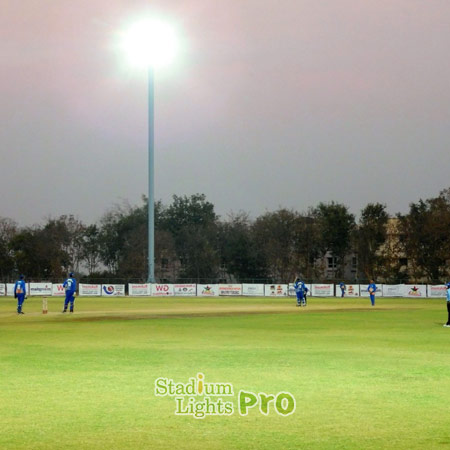Traditional cricket stadium lighting systems, primarily powered by electricity, can be expensive to operate and maintain, not to mention their impact on the environment. In recent years, solar lights have emerged as a viable alternative, offering numerous advantages in terms of sustainability and cost-effectiveness. This article explores the potential use of LED solar lights in cricket fields and stadiums, discussing their benefits, challenges, and overall feasibility.
Table of Contents
ToggleAdvantages of solar cricket stadium lights
Environmental sustainability
LED solar lights harness the sun’s energy, making them a clean and renewable source of power. By using solar energy, cricket fields and stadiums can significantly reduce their carbon footprint and contribute to environmental conservation.
Cost-effective
Although the initial investment for installing LED solar lights may be higher than traditional cricket lighting systems, solar lights offer long-term cost savings. Once installed, they require minimal maintenance and no ongoing electricity expenses, resulting in reduced running costs of cricket stadium lights.
Energy independence
Solar lights provide independence from the grid, eliminating the reliance on external power sources. This is particularly advantageous in remote areas or regions with unreliable electricity supply, ensuring uninterrupted illumination for cricket matches.
Flexibility and easy installation
Solar LED lights are versatile and adaptable, making them suitable for both permanent and temporary installations. They can be easily installed and relocated without extensive infrastructure requirements, offering flexibility in accommodating different cricket events and tournaments.
Challenges and considerations
Initial investment
 The upfront cost of installing solar lights can be a significant barrier for some cricket fields and stadiums. However, with advancements in technology and decreasing solar panel costs, the return on investment is improving, making solar lights a more viable option in the long run.
The upfront cost of installing solar lights can be a significant barrier for some cricket fields and stadiums. However, with advancements in technology and decreasing solar panel costs, the return on investment is improving, making solar lights a more viable option in the long run.
Intensity and consistency of lighting
Cricket requires consistent and high-quality lighting conditions, especially for professional matches. Ensuring that solar lights can provide sufficient intensity and maintain consistent performance throughout matches, regardless of weather conditions, is essential.
Battery storage and backup
Cricket matches often extend into the evening or night, requiring reliable lighting for extended periods. Adequate battery storage and backup systems are crucial to ensure uninterrupted illumination, even when sunlight is insufficient.
Maintenance and durability
Solar lights, like any other equipment, require regular maintenance to ensure optimal performance. Components such as solar panels, batteries, and LED lights need periodic inspection and potential replacement, which must be factored into maintenance plans and budgets.
Feasibility and future prospects
Despite the challenges, the use of solar lights in cricket fields and stadiums is feasible and holds significant potential. Advancements in solar technology, such as more efficient solar panels and improved battery storage, are continually enhancing the reliability and performance of solar lighting systems. Besides, governments and organizations are increasingly promoting renewable energy initiatives, offering grants and incentives that can offset the initial costs of installation.

How to install cricket field lights?
Installing solar cricket stadium lights requires careful planning and execution to ensure optimal performance and functionality. Here are the general steps involved in the installation process:
Site assessment
Begin by conducting a thorough site assessment to determine the suitability of the location for solar lighting installation. Consider factors such as available sunlight, shading, terrain, and proximity to existing infrastructure.
Design and planning
Collaborate with a professional solar lighting provider or an experienced engineer to design a customized lighting system based on the specific requirements of the cricket stadium. This includes determining the number and placement of light fixtures, solar panels, batteries, and control systems.
Obtain necessary permits
Check with local authorities to identify any permits or approvals required for solar lighting installations in cricket stadiums. Obtain all necessary permits to ensure compliance with local regulations.
Install solar panels
Begin by installing the solar panels in an optimal location where they can receive maximum sunlight exposure throughout the day. Ensure that the panels are securely mounted and angled correctly to maximize energy generation.
Battery and control system installation
Install the battery storage system and control equipment in a safe and accessible location. The battery system is essential for storing solar energy during the day for use during matches or when sunlight is limited.
Light fixture installation
Mount the light fixtures in strategic positions around the stadium, ensuring uniform lighting coverage and proper illumination of the playing area. Securely install the fixtures at the recommended height and angle for optimal lighting performance.
Wiring and electrical connections
Connect the solar panels, batteries, and light fixtures using appropriate wiring and electrical connections. Ensure that all connections are properly insulated, protected, and in compliance with electrical safety standards.
Testing and commissioning
Once the installation is complete, thoroughly test the system to ensure that all components are functioning correctly. Test the lighting levels, battery performance, and control system functionality to guarantee reliable operation.
Maintenance and monitoring
Establish a regular maintenance schedule to inspect and clean the solar panels, check battery health, and perform any necessary repairs or replacements. Implement a monitoring system to track energy production, battery status, and overall system performance.
Conclusion
Solar lights present a compelling alternative to traditional lighting systems in cricket fields and stadiums. Their environmental sustainability, cost-effectiveness, and energy independence make them an attractive option for the sport. While challenges such as initial investment, lighting intensity, and maintenance exist, continuous advancements in solar technology are gradually addressing these concerns. As cricket venues strive for greener and more efficient operations, solar lights are poised to play a vital role in transforming the way cricket matches are illuminated, contributing to a more sustainable future for the sport.
Feel free to reach out to us for a complimentary lighting design consultation tailored specifically to your solar cricket field lighting needs. Our team of experts is ready to assist you in exploring the possibilities and benefits of solar lighting solutions for cricket fields and stadiums. Don’t miss this opportunity to harness the power of renewable energy and create an eco-friendly, cost-effective lighting system. Contact us today and let us guide you towards a sustainable future in sports lighting.

